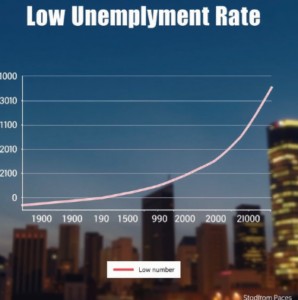
The January 2025 Job Market Snapshot
The U.S. job market faced a significant slowdown in January 2025, with just 143,000 new jobs added, falling short of the anticipated 170,000. This was a sharp decline from the 300,000 jobs added in December 2024. However, despite this underwhelming figure, the unemployment rate remained steady at 4%, maintaining the low levels seen throughout much of the recovery from the pandemic. This surprising combination of sluggish job growth paired with a resilient unemployment rate invites deeper examination into the factors at play.
This article delves into the reasons behind the slowdown in job growth, the factors keeping the unemployment rate low, and how these trends may influence U.S. economic policy moving forward. By looking at various contributors—including economic uncertainty, sector-specific shifts, weather disruptions, and labor market dynamics—we can understand how the labor market is navigating the challenges of 2025.
1. US Job Growth Slows: Key Reasons Behind the Slowdown
The job growth figures for January 2025 were certainly lower than expected, marking the weakest growth in several months. To better understand this decline, several factors must be considered:
1.1 Weather-Related Disruptions
Severe weather conditions, particularly winter storms in the Northeast and Midwest, played a large part in slowing job growth in January. The intense weather led to disruptions in industries that rely on outdoor activities, such as construction, agriculture, and transportation. For example, construction companies had to delay projects, retail businesses experienced lower foot traffic, and transportation services faced cancellations due to snow and icy conditions. These weather-related disruptions temporarily hampered the ability of employers in affected industries to hire workers, contributing to the slower-than-expected job growth for the month.
1.2 Economic Uncertainty and Inflationary Pressures
One of the biggest factors influencing job growth has been the economic uncertainty stemming from high inflation and the Federal Reserve’s interest rate hikes. As the Fed raised interest rates throughout 2024 to combat inflation, borrowing costs increased, making it more expensive for businesses to expand and hire. Many businesses, particularly small and medium-sized enterprises, began holding off on hiring, adopting a wait-and-see approach until they had a clearer view of the economic outlook. The decision to slow down hiring efforts in the face of rising interest rates and inflationary pressures contributed to the moderation in job creation in January 2025.
1.3 Restructuring and Layoffs in the Tech Sector
In the technology sector, a significant number of layoffs were seen as companies responded to over-expansion during the pandemic. Many tech giants, such as Meta, Amazon, and Microsoft, implemented hiring freezes and workforce reductions as part of their cost-cutting efforts. These companies had ramped up hiring during the pandemic to meet the surge in demand for tech services, but as the global economy recalibrated, these firms began trimming their workforces. While this trend was expected, it added to the overall slowdown in job growth as the tech industry accounts for a sizable portion of the U.S. labor market.
1.4 Automation and AI Integration
Another factor contributing to slower job growth is the increased adoption of automation and artificial intelligence (AI) by businesses. Many companies, particularly in manufacturing, retail, and administrative roles, are looking to integrate technology to reduce labor costs. AI and automation tools allow businesses to streamline operations, leading to fewer job openings. While these technological advancements are improving efficiency, they are also limiting the number of jobs that can be created, particularly in industries where automation is most applicable.
1.5 Shift in Business Hiring Strategies
In addition to external factors like weather and inflation, many businesses have adopted a more cautious approach to hiring. With rising costs, companies are focusing on optimizing their existing workforce rather than aggressively expanding it. Many firms are restructuring or refining their hiring processes, ensuring that new hires are critical to the organization’s long-term goals rather than adding positions simply to fill gaps. This approach contributes to a slower pace of job creation, as businesses become more selective about hiring.
1.6 Global Economic Pressures
Global economic conditions also played a role in the slowdown of U.S. job growth. Political instability in parts of Europe and Asia, along with concerns about inflation, impacted international trade and supply chains. U.S. companies with international dealings found it harder to maintain growth in the face of weaker global demand. The result was fewer opportunities to expand hiring in export-driven industries. In some cases, U.S. firms that rely heavily on global trade scaled back hiring as a precaution against further economic uncertainty.
1.7 Labor Market Volatility: Temporary vs. Long-Term Trends
Although January’s job growth was slower than expected, it’s important to consider this within the broader context of labor market trends. Job growth fluctuates due to a variety of short-term factors. It is too early to assume that this slowdown represents a long-term pattern. Economists often look at employment trends over several months, and one weaker-than-expected report does not necessarily signal a major downturn. Given that many of the factors influencing job growth in January were short-term (such as the weather and tech layoffs), the job market could rebound in the following months.
2. Unemployment Rate Stays Low: Resilience of the Labor Market
While job growth slowed in January 2025, the unemployment rate remained steady at 4%, which was a positive sign for the health of the U.S. labor market. Despite slower hiring, several factors contributed to the resilience of the unemployment rate:
2.1 Revised Job Gains from Previous Months
It’s important to note that the jobs numbers for the previous months were revised upwards, adding 100,000 jobs to the total for December and November 2024. This upward revision demonstrated that the labor market was in better shape than initially reported. These revised numbers helped offset the impact of the January slowdown and kept the unemployment rate stable.
2.2 Wage Growth and Inflation
Another factor that helped keep the unemployment rate low was the rise in wages. In January 2025, average hourly earnings rose by 0.5%, well above expectations. Wage inflation is a key indicator of labor market strength, as it suggests that employers are willing to pay more to attract and retain employees. Higher wages also help reduce turnover and increase job stability. As wages rise, people are more inclined to stay in their positions, further contributing to a low unemployment rate.
2.3 Labor Force Participation Rate Stability
The labor force participation rate, which measures the percentage of working-age people either employed or actively seeking work, remained steady. This is a positive sign, as it shows that people remain optimistic about finding work, despite the slower pace of job creation. More Americans have been re-entering the workforce, driven by opportunities in key industries and confidence in job prospects. This growth in participation supports the continued low unemployment rate.
2.4 Business Focus on Employee Retention
In response to the uncertain economic climate, many companies have been focusing on retaining their existing employees. With the ongoing competition for skilled workers, businesses have been making efforts to improve job security, offer better benefits, and invest in employee training. This focus on retention helps to reduce turnover and maintain low unemployment levels.
2.5 Key Sectors Continuing to Grow
While the overall pace of job creation slowed in January, some sectors continued to show growth. The healthcare industry, in particular, remained strong, with hospitals, nursing homes, and outpatient facilities continuing to hire at robust levels. Similarly, industries like construction and hospitality experienced consistent demand, although adverse weather conditions affected their hiring in January. As long as these sectors continue to hire, the unemployment rate is likely to stay low.
2.6 Impact of Unemployment Benefits and Support Programs
Unemployment benefits and other government support programs have also played a role in keeping the unemployment rate low. These programs provide financial support to those who are unemployed or underemployed, enabling them to stay in the labor market while they search for new opportunities. Government initiatives aimed at improving job training and placement services have further helped to maintain a strong labor market.
2.7 Resilience in the Face of Challenges
Despite slower job growth, the labor market has proven to be resilient in the face of challenges such as inflation, economic uncertainty, and sector-specific shifts. The 4% unemployment rate signals that many workers have been able to secure and maintain employment, even amid short-term disruptions. With a steady unemployment rate and continued demand for workers in key industries, the U.S. job market remains strong.
3. Implications for Federal Reserve Policy
The January slowdown in job growth, coupled with a steady unemployment rate, has important implications for Federal Reserve policy. The Fed closely monitors both job growth and unemployment in its decisions regarding interest rates and monetary policy. Here’s how the latest data may affect the Fed’s approach:
3.1 Economic Uncertainty and Rate Hikes
The Federal Reserve has been raising interest rates in an attempt to curb inflation, and January’s slower job growth may signal that the economy is feeling the effects of these hikes. As businesses face higher borrowing costs, they may be more hesitant to expand their workforces. The Fed will likely continue to monitor these developments closely. If the job market remains sluggish in the coming months, the Fed may choose to pause further rate hikes to prevent stifling economic growth.
3.2 Wage Growth and Inflation Control
While wage growth is typically seen as a positive sign of a healthy economy, it can also contribute to inflationary pressures. The 0.5% rise in wages in January could lead to higher consumer spending, which, in turn, may push inflation up. The Fed will likely take this into consideration when making future decisions about interest rates. If inflation continues to rise despite slower job growth, the Fed may decide to tighten policy further.
3.3 Maintaining Economic Stability
The Fed’s primary goal is to maintain economic stability, which involves balancing job growth with inflation. While the slower job growth in January may be concerning, the steady unemployment rate and wage gains suggest that the labor market remains relatively healthy. The Fed is likely to adopt a wait-and-see approach, waiting for more data before making significant changes to its policy.
Navigating the Complex Labor Market of 2025
In conclusion, while job growth in January 2025 was slower than anticipated, the U.S. economy continues to show resilience in the face of challenges. The steady unemployment rate of 4% highlights the strength of the labor market, even as businesses adopt more cautious hiring practices. Weather-related disruptions, economic uncertainty, and technological shifts have all contributed to the slower pace of job creation, but the overall labor market remains strong.
Looking ahead, the Federal Reserve will closely monitor these developments as it balances its goals of fostering job growth and controlling inflation. Despite the challenges faced in January, the U.S. labor market remains poised to continue its recovery, with steady unemployment and growth in key sectors. As the year progresses, we may see further fluctuations in job growth, but the outlook for the labor market remains positive overall.
Feel free to check out our other website at : https://synergypublish.com

